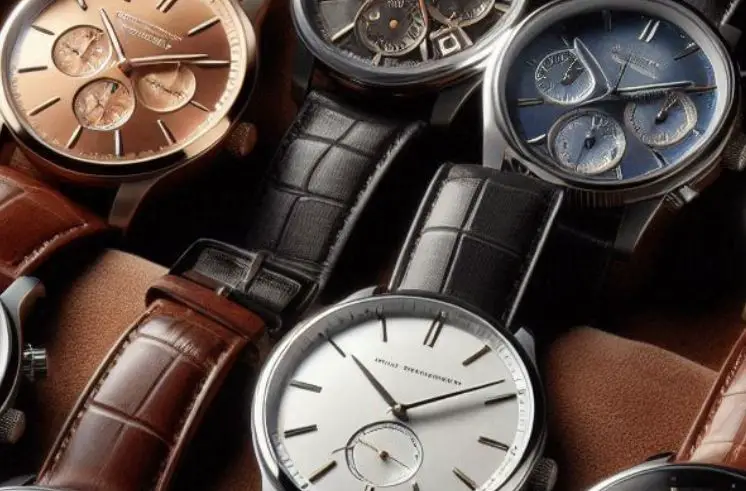Last updated on October 20th, 2025 at 04:42 am
Discover how to choose the right watch that suits your lifestyle and fits your wrist flawlessly. Style, function, and comfort, find the ideal timepiece that works for you.
Lifestyle factors have a role in the kind of wristwatches you own as a true gentleman.
You don’t wear the same shoes to the gym and the office, so why should your watch be any different?
As one of the essential fashion accessories for modern men, the timepiece you choose should match how you live, what you do, and how you carry yourself.
From business meetings to weekend hikes, the right watch needs to keep up with you without feeling out of place.
And it’s not just about features, fit matters too. A watch that’s too big or too small can throw off your entire look.
That’s why wrist size is just as important as style and function. In this guide, you’ll learn how to choose a watch that works with your lifestyle and feels right on your wrist.
Related: Why Choose a Diver Watch When You Are Not a Diver?
Table of Contents
- Understanding Your Lifestyle Needs and Daily Routine
- Match the Watch to Its Purpose
- Watch Types and How They Fit into Your Lifestyle
- How to Choose the Right Watch Size for Your Wrist
- How to Choose a Watch That Matches Your Budget
- Final Tips Before You Buy a Watch
- Frequently Asked Questions
- Conclusion
Understanding Your Lifestyle Needs and Daily Routine
Lifestyle factors have a role in the kind of wristwatches you own as a gentleman.
You’re not buying just a timepiece, you’re picking something that fits into your routine, your work, and your taste.
So before anything else, ask yourself: What do I actually need this watch for?
Your day-to-day life says a lot about the kind of watch that will work for you.
If you spend most of your time in meetings, suits, or office settings, you’ll want something simple, polished, and reliable.
A dress watch with a clean face and leather or metal strap will sit well under a cuff.
If your days are more active or unpredictable, construction, travel, field work, or gym sessions, then durability matters.
You’ll need something sturdy with water resistance, scratch protection, and practical features like a stopwatch or calendar.
Related: Pros And Cons Of Quartz Vs Automatic Watches
Match the Watch to Its Purpose

Use this checklist to match your needs to common watch features:
Business Wear: Classic Design, Slim Case, Neutral Colors
Business watches feature timeless, elegant designs with slim cases that fit comfortably under shirt cuffs.
Neutral colors like black, silver, or gold ensure versatility and professionalism.
These watches complement formal attire, projecting a polished and refined image suitable for meetings, presentations, and office environments.
Travel: Multiple Time Zones, Long Battery Life, Readable Dial
Travel watches offer practical features like tracking multiple time zones, making it easy to stay synchronized globally.
Long battery life ensures reliability on long trips, while a clear, readable dial allows quick time checks even in low light.
These features support frequent travelers and jet-setters efficiently.
Fitness: Heart Rate Tracker, Step Counter, Rubber Strap
Fitness watches are designed for active lifestyles, equipped with heart rate monitoring and step counting to track health metrics accurately.
Rubber straps provide durability and comfort during workouts, resisting sweat and moisture.
These watches help users stay motivated and informed about their physical activity and wellness goals.
Outdoors: Shock Resistance, Compass, Solar Charging
Outdoor watches are rugged and built to endure harsh conditions. Shock resistance protects against impacts, while integrated compasses aid navigation.
Solar charging extends battery life during extended adventures, making these watches perfect companions for hiking, camping, and other outdoor pursuits.
Casual Wear: Minimalist or Fashion-Forward Style
Casual watches balance style and simplicity, often featuring minimalist designs or trendy, fashion-forward looks.
They provide versatility to suit everyday wear and relaxed occasions, allowing wearers to express personal style without overwhelming the outfit.
Casual watches prioritize comfort while enhancing the overall look effortlessly.
Consider Where You Work
Does your job call for a conservative appearance, or can you get creative? In a formal workplace, go with something subtle.
If you’re in tech, media, or design, you’ve got room to show more personality through color, shape, or brand.
Related Posts
- Pocket Watches: Are They Still Relevant?
- Cartier Men’s Watches
- Extending the lifespan of men’s watches
- Men’s Watches Under $100
- Guide to Luxury Men’s Watches
- Best Men’s Watches Under $1000
- What are Watch Complications?
- Popular Men’s Watches: Timeless Timepieces That Never Go Out of Style
- Best Watches for Modern Gentlemen According to Affordability, Luxury and More
Watch Types and How They Fit into Your Lifestyle

Picking the right watch starts with understanding what you do each day and how a timepiece will fit into that rhythm.
It also comes down to wrist size and comfort. Once you’ve figured out your lifestyle needs, the next step is choosing the type of watch that matches them.
Dress Watches: For Formal and Professional Settings
If you wear suits or attend formal events, a dress watch might be what you need. These watches have slim cases, simple faces, and clean lines.
They slide under a shirt cuff without drawing too much attention. Use them for work, weddings, dinner parties, or any setting that calls for a sharp look.
Stick to leather or metal straps and keep it minimal.
Sports Watches: For the Physically Active
Do you run, swim, hike, or hit the gym regularly? Then look for a sports watch. These are built for movement.
They usually come with water resistance, a durable case, and features like a stopwatch, timer, or rotating bezel.
The straps are often rubber or reinforced fabric for extra grip. If you’re into swimming or high-impact sports, make sure the watch can take a hit and still work.
Smartwatches: For the Connected Lifestyle
If you rely on your phone throughout the day or like tracking your steps, sleep, or heart rate, a smartwatch gives you everything in one place.
It connects to your phone and keeps you updated on calls, texts, and notifications.
Fitness trackers, reminders, and app syncs make it a solid pick for daily use, especially if you prefer convenience on the go.
Field Watches: For Outdoor and Adventure Use
You spend weekends in the woods, hike mountains, or work in hands-on environments? A field watch is simple, rugged, and made to survive tough conditions.
Most have readable dials, strong casing, and features like compasses or altimeters.
They’re a solid choice for camping, construction, or tactical use.
Casual Watches: For Everyday Style
Sometimes, you just want a watch that looks good without doing too much. That’s where casual or fashion watches come in.
You’ll find more variety in shapes, colors, and designs. These watches let you show your style, whether you’re dressing down or trying something different.
They don’t need advanced features, just a look that fits your mood or outfit.
Match Watch Type with Wrist Size
A large dial might work for a bigger wrist, but could look bulky on a smaller one. A slim profile suits a narrow wrist better.
Comfort matters. Try watches on when possible or check size guides online. A watch should feel right, not just look right.
The best pick is the one that fits your life and feels good on your wrist. Want help choosing by wrist size next?
How to Choose the Right Watch Size for Your Wrist
Getting the right watch size is just as important as picking the right style. A watch that fits well not only looks better but also feels better throughout the day.
Start by Measuring Your Wrist
Use a flexible tape measure or a piece of string. Wrap it around your wrist just above the wrist bone.
If you’re using string, mark where it meets, then measure that length with a ruler. This number is your wrist size.
Here’s a general guide for wrist size categories:
- Small: under 6.5 inches
- Medium: 6.5 to 7.5 inches
- Large: over 7.5 inches
Once you know your size, it becomes easier to filter your choices.
Match the Watch Case to Your Wrist
The case size, measured in millimeters, is the width of the watch face. Here’s a simple breakdown:
- 36 to 40mm: fits smaller wrists
- 40 to 44mm: works for medium wrists
- 44mm and above: better for larger wrists or bold styles
As a rule of thumb, the case width should be around half the width of your wrist. That keeps things balanced and avoids a bulky or undersized look.
Pay Attention to Case Thickness
A thicker watch may feel heavier and stick out more. Thinner watches usually sit closer to the wrist and slide under your shirt cuff more easily.
If comfort matters to you, keep an eye on thickness.
Choose a Strap That Fits Right
Straps change how a watch feels and wears. Leather straps mold to your wrist over time.
Metal bracelets may need links removed for a better fit. Rubber or nylon bands offer more flexibility and are great for daily or active use.
The goal is to make sure the watch doesn’t slide around or pinch. Try adjusting the strap or bracelet to see what feels best.
How to Choose a Watch That Matches Your Budget
Before you start shopping, decide how much you’re willing to spend.
This helps narrow your choices and keeps you focused on what matters most to you: style, quality, or brand value.
Set a Realistic Budget
Ask yourself: Are you buying a watch for daily use, work, special events, or as a long-term piece? Your answer will help guide your budget.
- If you want a luxury piece: Brands like Rolex, Omega, or TAG Heuer offer watches known for craftsmanship and reputation. These come at a high price, but if you value prestige and timeless design, they might be worth the spend.
- If you’re keeping costs down: Brands like Seiko, Citizen, and Fossil give you good-looking watches with reliable performance. They’re trusted, affordable, and work well for everyday use or casual outfits.
What You Can Expect at Each Price Range
- Under $200: Look for quartz watches with basic features and solid build quality. You’ll find good options for work or casual wear.
- $200 to $500: Expect better materials, automatic movements, and more variety in design. You can find stylish watches that work for both business and weekend looks.
- $500 to $2000: Here, you’ll see premium features like sapphire glass, Swiss movements, and polished finishes. These watches balance performance with presence.
- $2000 and up: This is where craftsmanship meets collectibility. Watches in this range are built to last decades and hold value over time. Think of them as heirloom pieces or status markers.
Make Smart Money Moves
Don’t stretch your budget for a name. Focus on value, comfort, and style that fits your wrist and your needs
Compare prices from official brand websites, retailers, and trusted marketplaces
Read user reviews and expert watch blogs to see how different models perform over time
Watch for seasonal sales or clearance deals, especially from authorized dealers
Final Tips Before You Buy a Watch
Before you commit to a watch, slow down and think beyond the look. A few smart checks now can save you money and disappointment later.
Know the Brand
Some brands have built their reputation over decades. When you see names like Rolex, Seiko, or Citizen, you’re not just buying style, you’re buying proven quality.
Take time to read the brand’s history. What do watch owners say? Check reviews and testimonials on forums and trusted retail sites.
They’ll tell you how that brand holds up in real life.
Understand the Warranty
Check the warranty details. A good one usually covers the movement and sometimes even damage from regular wear.
Avoid vague or limited warranties. If a brand stands by its product, the warranty will show it.
You’ll thank yourself if something goes wrong months after buying.
Read Real User Reviews
Skip the ads and read what real people say. Reviews can tell you things specs never will:
- Comfort: Does it feel heavy or balanced on the wrist?
- Accuracy: Does it keep time well or need frequent resets?
- Build: Are there any common complaints about parts wearing out too soon?
You can also ask friends, family, or fellow collectors. Personal feedback can point you toward models that match your lifestyle and wrist size.
In-Store or Online: What’s Better?
Try both if you can.
In-store shopping gives you:
- A chance to see the watch on your wrist
- Help from a salesperson who knows the details
- Peace of mind from buying in person
Online shopping gives you:
- Access to rare or discounted models
- Time to compare features and prices
- Customer reviews at your fingertips
If you go online, buy from trusted sites. Look for secure payment options and a clear return policy in case the watch doesn’t meet your expectations.
Frequently Asked Questions
What watch size fits small wrists best?
Watches with case diameters between 36 to 40 millimeters typically suit smaller wrists, balancing comfort and style without looking bulky.
Should I buy a watch online or in-store?
Try both. In-store helps with fit and advice; online offers more options and reviews, but buy only from trusted sellers.
What features should a sports watch have?
Look for water resistance, a durable casing, a stopwatch, a timer, and comfortable straps like rubber or reinforced fabric for active use.
How do I match a watch to my lifestyle?
Consider your daily activities, office, sports, and outdoors, and choose features like durability, style, or smart functions that fit your routine.
Conclusion
You don’t need to rush when picking a watch. Think about your day-to-day life and how the watch will fit into it.
Are you active and need something sturdy, or do you spend most of your time in a work setting where a more refined look makes sense? That matters.
Next: measure your wrist. A watch that fits well not only feels better but looks better too.
Use your measurement to compare with case sizes and strap lengths before buying.
Then look at what speaks to you. From the dial design to the strap material, let your style guide you.
The right watch reflects who you are and what you do.
Pyo Merez is a men’s lifestyle enthusiast and writer about the gentleman’s place and impact on society. Raised by a distinguished gentleman dad, he offers unique insights into how the mind of a gentleman works and how societal norms shape gentlemen’s identity and vice versa.
Through his insightful articles, Pyo taps into the depths of gentleman culture to provide perspectives on etiquette and manners in modern society.

